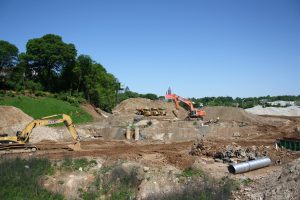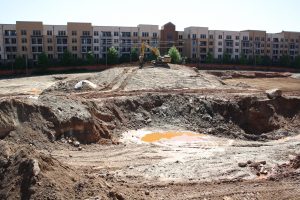Glenwood Road Removal Action

This former 22-acre industrial site was under development for residential and retail space when high levels of lead were discovered in one of the excavations. An environmental consulting firm was monitoring the on-site excavations and was routinely sampling at varying depths. Upon discovered of highly contaminated levels of soil, KEMRON was contacted and met with the environmental consultant, the general contractor and developer to discuss remediation options. Due to the very tight construction schedule, the primary concern was working closely with general contractor to not hinder progress if at all possible.
To expedite the process, KEMRON personnel immediately collected soil samples from previously identified stockpiles with known high concentrations of lead and delivered them to KEMRON’s in-house treatability lab. KEMRON’s lab conducted a treatability study for stabilization of soils with reagents. The treatability study was conducted over three days and was proven successful in binding the lead to achieve TCLP levels below 1ppm ml/kg. KEMRON developed a work plan that involved excavating contaminated soil from the source, blending the stabilization agent in the soil, and arranging transportation and disposal of the treated soil to a Sub-title D landfill. Due to time constraints, the work was scheduled to begin the following week. KEMRON’s safety manager developed a site specific safety plan and an air monitoring program for the site.

KEMRON mobilized the following week and began soil excavation while awaiting landfill approvals. Excavated soil was placed in a staging area in preparation for mixing with the stabilization agent. The stabilization agent was delivered in one ton supersacks and mixed into the soil at a 2.5% to 3% dosage. The treated soil was stockpiled in 500 ton piles and sampled for treatment confirmation.
Initially, KEMRON was asked to base the scope of work on an estimated volume of 1000 tons. Within a few days, it was became apparent that the extent of the contamination was much more widespread than originally thought. KEMRON met with the stakeholders and proposed a plan to ramp up the production to keep the project on schedule. Larger and additional equipment was brought on site so that excavation, treatment and truck loading could continue simultaneously throughout the day. Eventually, KEMRON treated and disposed of more than 20,000 tons of contaminated soil. KEMRON was recognized by the general contractor as being a key factor in keeping the project on schedule.